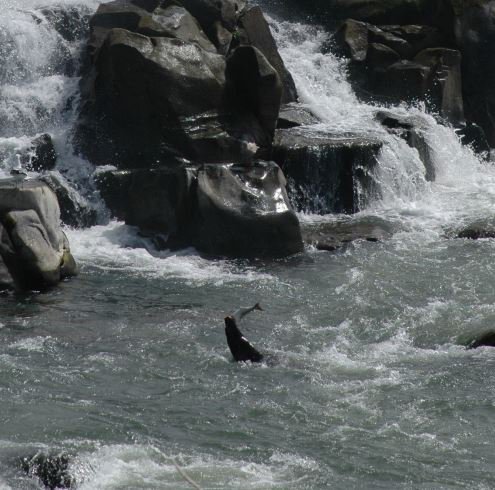Sea Lions in the Willamette
Hazing, relocation to the ocean prove ineffective at deterring sea lion predation on fish at Willamette Falls.
- May 29, 2018
- John Harrison

Willamette winter steelhead, a threatened species, are in serious trouble, and predation by sea lions at Willamette Falls is making their situation worse.
There are nine populations of Willamette steelhead in tributary basins upstream of Willamette Falls. The species was listed under the Endangered Species Act in 1999. While a number of factors are driving down the population, predation by sea lions is a key contributor. Predation this year has been in the range of 20 percent, the Oregon Department of Fish and Wildlife (ODFW) reported.
ODFW has applied for a federal lethal take permit to try to reduce the sea lion pressure on the wild run, which numbered just 512 fish passing Willamette Falls in 2017, according to an August 2017 news release from the Oregon Department of Fish and Wildlife. The agency has estimated that unless something is done to reduce predation, there is an 89 percent chance the run will go extinct.
Hazing the sea lions from boats and attempting to deter them using noisy cracker shells have been ineffective. ODFW tried capturing and relocating several of the most aggressive sea lions to the Oregon coast south of Newport this spring, but that, too, didn’t work. The sea lions were back at Willamette Falls, a distance of 210 miles, within four to six days.
Sea lions are also preying on sturgeon and lamprey at the falls, as they also do at Bonneville Dam on the Columbia River.
In an ODFW news release in April 2018, Dr. Shaun Clements, ODFW’s senior policy advisor, said protecting salmon, lamprey, and sturgeon from the onslaught by sea lions is difficult, and the predation is frustrating. “This isn’t just about the Willamette steelhead, which we know are in serious trouble,” Clements said. “We also know that predation on white sturgeon has increased dramatically this year, and that sea lions are preying on salmon, steelhead, and sturgeon in other rivers like the Sandy and Clackamas. Effective management will only be possible if the U.S. Congress changes the law to allow managers to proactively prevent sea lions habituating to these bottlenecks in freshwater.”
ODFW will leave its sea lion traps in place on the Willamette but move over to the Columbia in the Bonneville Dam tailrace, where the agency had limited federal authorization to lethally remove sea lions. In the same ODFW news release, Bryan Wright, ODFW’s marine mammal program lead said, “It’s disheartening given what’s happening in the Willamette, but we don’t have enough staff to cover both locations so we’re moving to a place where we can be more effective.”
ODFW has applied to the federal government for authorization to lethally remove sea lions that are eating salmon and steelhead at Willamette Falls under Section 120 of the Marine Mammal Protection Act. Even if that application is approved, it won’t be until 2019 at the earliest.
Meanwhile, as the West Coast California sea lion population has reached its carrying capacity of about 300,000 animals, according to NOAA Fisheries, legislation has been introduced in Congress that would amend the Marine Mammal Protection Act to speed the process of removing the few, most problematic sea lions that prey on salmon and steelhead in the Columbia River and in tributaries that support threatened and endangered species, like the Willamette. ODFW and the Council support the legislation.
In a letter to U.S. Sen. James Risch (R-Idaho) who introduced the legislation in the Senate, the Council commented: “All other sources of mortality are being reduced while predation by sea lions increases. It is time to update the Marine Mammal Protection Act to speed the process of removing the most problematic sea lions.”
(Above image: Sea lion with a fish at the base of Willamette Falls. Photo: Oregon Department of Fish and Wildlife)
View a video, taken by our Western Washington Council Member Guy Norman, of a sea lion attacking a sturgeon in the Willamette River.


